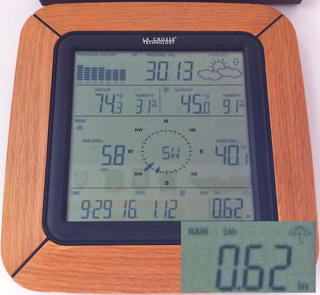
IC2118 (Witch Head Nebula)
Posted: 18 January 2012
The sky was overcast on Saturday, 14 January, and it stayed cloudy until Tuesday, 17 January. There was 0.62" of rain overnight 15-16 January, as reported by my new weather station:

On my previous report, I noted that my new observatory clock had failed. After the failure, it did come back on, but the "units" digit in the seconds display sometimes showed a missing bar:

On Monday, 16 January, I contacted the dealer requesting an exchange. I am waiting for a response.
The observatory was opened Tuesday, 17 January, at 1810 MST, 56°F. There were a few clouds to the southwest. When I entered the observatory, I noticed that the digital clock had locked up again after working OK for several days. I disconnected it and reconnected my decades old digital clock. I have given up on the new clock working reliably.
After wiping off water on the dome from the recent rain, I opened up the dome and at 1821 MST, viewed Venus at 77X. Then Jupiter at 77X and 206X. Seeing was very bad and at 206X, Jupiter would frequently blur completely out.
I began preparing to image IC2118, the Witch Head Nebula, a very faint diffuse nebula, with the D7000 DSLR piggyback on the 8" LX200-ACF. I found a good guide star and at 1900 MST, with some clouds approaching the target area, I began imaging. I took 5 minute, ISO 6400, and 10 minute, ISO 4000, guided exposures at f/4.8, focal length 135mm. This is the 10 minute exposure. slightly cropped:

The image has been rotated to better show the "witch head". The witch is looking at Rigel at upper right.
At 1920 MST, I ended IC2118 imaging and did some more imaging tests for some software reviews I am working on. The tests were completed at 2137 MST. The temperature was now 46°F. The humidity had been climbing during the evening and was now 62%. There was a distinct "dampness" to the air. I did some brief viewing of M42 in Orion at 77X and 206X before closing up due to the high humidity and poor seeing.
Closed the observatory at 1953 MST, 45°F.
Go to the previous report.
Return to the Cassiopeia Observatory Welcome Page.